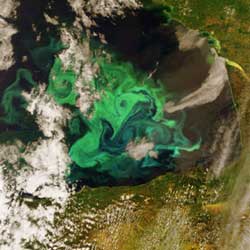
Envisat image of a plankton bloom of the coast of Spain. Image credit: ESA. Click to enlarge.
A break in the clouds in an Envisat observation of the west coast of Europe this week reveals a striking marine phytoplankton bloom currently dominating the Bay of Biscay.
Phytoplankton are microscopic marine plants that drift on or near the surface of the sea, by far the most abundant type of life found in the ocean. Just like plants on land they employ green-pigmented chlorophyll for photosynthesis – the process of turning sunlight into chemical energy.
While individually microscopic, phytoplankton chlorophyll collectively tints the surrounding ocean waters, providing a means of detecting these tiny organisms from space with dedicated ‘ocean colour’ sensors.
As if dye had been placed in the water, the greenish colour highlights whirls of ocean currents. Floating freely in the water, phytoplankton are sensitive not just to available sunlight but also to local environmental variations such as nutrient levels, temperature, currents and winds. Favourable conditions lead to concentrated ‘blooms’ like the one we see here.
Monitoring phytoplankton is important because they form the base of the marine food web ? sometimes known as ‘the grass of the sea’.
On a local level, out-of-control blooms can devastate marine life, de-oxygenating whole stretches of water, while some species of phytoplankton and marine algae are toxic to both fish and humans. It is useful that fishermen, fish farmers and public health officials know about such events as soon as possible.
Globally, phytoplankton are a major influence on the amount of carbon in the atmosphere, and hence need to be modelled into calculations of future climate change.
Phytoplankton blooms occur frequently at this time of year in the Bay of Biscay. This ‘spring bloom’ takes place as cold, nutrient-rich waters are finally exposed to sufficient sunlight to trigger rapid phytoplankton growth. The bloom is signaling a new cycle of biological production, important for the local fishing industry – the Bay of Biscay being a rich fishery.
Envisat’s Medium Resolution Imaging Spectrometer (MERIS) instrument is optimised for ocean colour detection, but also returns detailed multispectral information on land cover, clouds and atmospheric aerosols.
MERIS acquires continuous daytime observations in Reduced Resolution mode as part of its background mission. This is a detail from a MERIS Reduced Resolution image was acquired on 2 May 2005. The full version, viewable by clicking the high-resolution image, has a spatial resolution of 1200 metres and covers an area of 838 by 2277 km.
Original Source: ESA News Release
